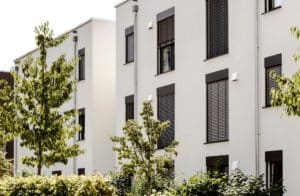Building Performance Evaluation is a means of using different monitoring techniques to evaluate a building’s performance. Read our blog to find out more.
Right now, there’s still a limited use of the Building Performance Evaluations (BPE) being used routinely on projects within the construction industry, As a result, new homes often fail to meet low-energy targets and consequently, fail to satisfy residents on areas such as ease of use, summer comfort and energy costs. With the UK striving to meet their goal of achieving Net Zero Carbon by 2050, BPE will help developers to calculate more accurate energy usage as well as make homes more comfortable and enjoyable to live in.
But, what is Building Performance Evaluation and how can it help developers within the construction industry? In this blog, we will be discussing what Building Performance Evaluation is and why it is so important in today’s industry.
What is Building Performance Evaluation (BPE)?
BPE (Building Performance Evaluation) is a key element of the BSRIA soft landings framework, which was created to help produce buildings that are effective, efficient and perform as expected. Used on both new and existing builds, it is implemented at multiple points in a building’s life to help developers access energy performance and occupant comfort to compare with design targets. It provides information about a building’s performance such as:
- Building fabric
- Energy use
- Occupant comfort and satisfaction
- Building services and operating strategies
Detecting faults within these areas will help developers to create a strategy that is ‘bump free’ for the transition from construction to occupation. And it’s no surprise that BPE (Building Performance Evaluation) is rapidly becoming a requirement for many projects due to many companies requesting a proof of performance, particularly in projects in the public sector such as schools and healthcare buildings.
Catherine England, BSRIA Marketing Officer has said that the construction industry is still missing the mark when it comes to building performance. “Recent research from academia and industry has shown that buildings do not always perform in the way that was originally intended. BPE is the process of evaluating how a building performs and can be used on both new and existing buildings in order to address these issues”
What is Post Occupancy Evaluation (POE)?
Both BPE and POE (Post Occupancy Evaluation) are quite similar and can cause a bit of confusion when discussed within the industry, but POE is quite different. It’s the process of acquiring feedback on a building’s performance in use AFTER it has been built and occupied. It was created to help developers to identify pros and cons of a buildings design and how and if it achieves the needs of its occupants, looking into areas such as:
- Delivery success
- Completed development
- Where there is space for further improvement
- What future projects can learn
To complete a POE, developers will need to collect feedback from occupants through avenues such as survey questionnaires and interviews which should be conducted one year after building occupation, allowing for one seasonal cycle. This will help to identify their opinions on areas such as indoor environmental quality (such as thermal comfort, indoor air quality and lighting), energy auditing and external envelope studies.
What are the different elements of a Building Performance Evaluation?
A Building Performance Evaluation (BPE) has multiple different elements to consider such as:
- A forensic walkthrough
This includes an inspection to check the building’s operation which will identify whether there’s any emerging problems or operational issues.
- Energy Survey
A survey will provide a breakdown of the energy used in a building, including heating, air conditioning and so on.
- Assessment of Occupant Satisfaction
Surveys and interviews are conducted to help gain an understanding of building users and occupiers feelings and satisfaction.
Being able to conduct these elements will help developers to identify problem areas and what they need to do next to improve the builds performance and their occupant’s satisfaction levels.
Who needs a Building Performance Evaluation?
From evaluators and owners of a building to surveyors and housing developers, anyone within the construction industry can take advantage of a Building Performance Evaluation (BPE). Whether you are looking to identify energy performance inefficiencies or occupant satisfaction within your build, the BPE (Building Performance Evaluation) can help you to improve how your building is performing, whether it’s new or existing and identify the areas and issues that need addressing during any stage of the project.
Can Buildpass help me with my Building Performance Evaluation?
At Buildpass we offer as-built building performance testing including thermal imaging, air tightness testing, and in-use monitoring. Get in touch to see how we can help.




















